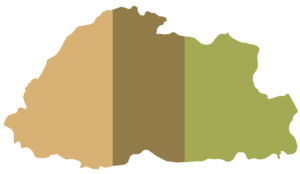
Nestled in the Eastern Himalayas between India and Tibet, Bhutan is a land of snow-capped peaks, lush green gorges, crystal-clear rivers and majestic fortress-like monasteries clinging to sheer cliffs. Bhutan’s colourful culture with its genuinely hospitable people, tsechus (dance festivals), archery competitions, deeply rooted beliefs and unique philosophies of life make it a destination like no other. Bhutan’s natural beauty and spirit leaves visitors breathless.
Bhutan is a pioneer of sustainable tourism, with its ‘High Value, Low Volume’ tourism model. Every visitor directly contributes to developing and preserving this haven through the government’s Sustainable Development fee (SDF). Recent changes to the SDF have made Bhutan an even more attractive place to visit, rewarding those who take the time to explore this magical, mystical land. Just get in touch with us and we’ll be happy to explain the changes to the SDF or anything else about Bhutan.
In a world which sometimes feels crowded no matter where you turn, Bhutan rewards visitors with the tranquillity and intimacy of experience that few places on the planet can rival. There is stunning natural beauty all around, but you’d be hard pressed to find a queue of Instagrammers waiting for their turn to capture the vistas.
Those who have visited India or Nepal will find that Bhutan’s culture and history is truly unique. It has a very different vibe from its subcontinental neighbours, making it a special place to visit. Bhutan is an excellent choice for a two country break when combined with Northern India, as most international visitors choose to fly into Delhi before catching connecting flights to Paro.
‘Green’ travellers will find Bhutan perfectly suited to their desire for leaving minimal carbon footprints. Tourism revenue is guaranteed to help the nation’s sustainable development, and everywhere you go, you’ll meet locals who have a deeply ingrained respect for their environment.
Whether you wish to travel on one of our suggested itineraries, join a small-group tour, or simply be inspired by them to build your own adventures, we are there to help create your perfect holiday.
Central Bhutan has several interconnected national parks and sanctuaries, linking habitats from the icy north to the southern jungles.
The largest reserve is the Wangchuck Centennial Park, covering altitudes from 2500- 5000 metres and consisting mostly of blue pines and Alpine meadows. It contains the headwaters of four main Bhutanese rivers and is home to Takins, Snow Leopards, Black Bears and more than a hundred species of birds.
The Jigme Singye Wangchuck National Park covers much of the Trongsa district. From the southern subtropical vegetation, it rises towards the chir pine, broad-leaved and conifer forests, meadows and snow of the north. Home to more than 450 bird species (resident and migratory), and Himalayan Bears, Red Pandas and even Tigers.
Along the southern border of Bhutan lies the Phibsoo Wildlife Sanctuary, Bhutan’s last natural sal forest. Hornbills, Spotted Deer, Elephants, Tigers and Gaur live here.
Royal Manas Natonal Park, separated from Assam’s World Heritage listed Manas National Park by the Manas river, is the oldest reserve in Bhutan. It has a rich variety of wildlife such as the Indian Rhinos, Clouded Leopards, Water Buffaloes, Tigers, Elephants, Gangetic Dolphins (in the Manas river) and rare Golden Langurs.
Outside of the national parks, one may encounter spectacular scenery and possibly wildlife sightings on half or full day walks. The Motithang Takin Preserve in Thimpu is ideal for having a look at this curious animal if you don’t have time to visit the national parks. The Botanical Garden in Serbithang is full of native and exotic trees, shrubs and herbs, orchids and fabulous rhododendrons.
The Royal Botanical Park has trails going into the Jigme Dorji National Park, where you may encounter Musk Deer, Red Panda, handsome pheasant varieties such as the blood pheasant or the beautiful Monal. Bears and other large creatures hide deep in the forest are are rarely seen. The area is popular with birders with more than 650 species recorded in the area.
Opulent: Exceptional, unashamedly the best of sheer luxury. (£££££)
Luxury: Outstanding levels of 5* comfort, hospitality and facilities. (££££)
Premium: Excellent levels of comfort and hospitality and a wide range of facilities. (£££)
Mid-Range: Good levels of comfort and hospitality, with a reasonable range of facilities. (££)
Simple: Clean and simple, no frills. Often in areas of natural beauty or near wildlife reserves. (£)